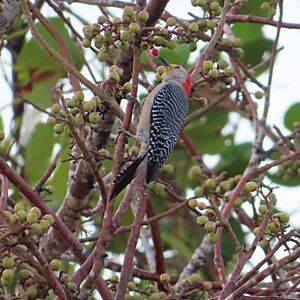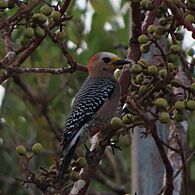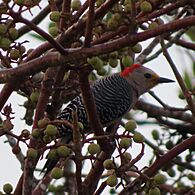Yucatan woodpecker facts for kids
Quick facts for kids Yucatan woodpecker |
|
|---|---|
 |
|
| An adult woodpecker eating fruit from a jocote tree in Celestún, Yucatán, Mexico | |
| Conservation status | |
| Scientific classification | |
| Genus: |
Melanerpes
|
| Species: |
pygmaeus
|
 |
|
| Synonyms | |
|
Centurus pygmaeus |
|
The Yucatan woodpecker (scientific name: Melanerpes pygmaeus) is a type of bird. It belongs to the woodpecker family, called Picidae. Sometimes, people call it the red-vented woodpecker because of a red patch on its belly.
You can find the Yucatan woodpecker in Belize and Mexico. It lives all over the Yucatán Peninsula. These birds like to live in dry forests, bushy areas, and even in forests that have been changed by people.
Contents
What Does the Yucatan Woodpecker Look Like?
An adult Yucatan woodpecker is about 17 cm (6.7 in) long. That's about the length of a regular pencil!
Feather Colors and Patterns
Most of their face and underparts are light gray. Their back, wings, and tail have cool black and white stripes.
Male and female Yucatan woodpeckers look a little different.
- Male woodpeckers have a red cap that goes from their eye all the way to the back of their neck.
- Female woodpeckers only have a red patch on the back of their head.
Both males and females have yellow feathers around the bottom of their beak. Their belly might look a bit yellowish, and they can have a red color near their vent area (the opening where birds get rid of waste).
How to Tell it Apart from Similar Birds
The Yucatan woodpecker looks a lot like another bird called the golden-fronted woodpecker (Melanerpes aurifrons). This other woodpecker also lives in the Yucatán Peninsula. It can be tricky to tell them apart!
Here are some ways to spot the differences:
- The golden-fronted woodpecker is bigger and has a longer beak.
- Female golden-fronted woodpeckers have more red on the back of their neck than female Yucatan woodpeckers.
- The golden-fronted woodpecker has reddish feathers around its beak, while the Yucatan woodpecker has yellow ones.
- From far away, the stripes on the golden-fronted woodpecker's back look blackish. The Yucatan woodpecker's stripes look more silvery.
- Their calls are also different!
There's also the red-crowned woodpecker (Melanerpes rubricapillus), which looks similar. But you won't find the Yucatan woodpecker and the red-crowned woodpecker in the same places.
Types of Yucatan Woodpeckers
The Yucatan woodpecker has three different types, called subspecies. They are:
- M. p. pygmaeus (found on Cozumel Island)
- M. p. rubricomus (found from the Yucatán Peninsula south to central Belize)
- M. p. tysoni (found on Guanaja Island, near Honduras)
Where Do Yucatan Woodpeckers Live?
The Yucatan woodpecker lives only in Central America. Its home includes the Yucatán Peninsula and nearby islands like Cozumel Island. You can also find it in Belize, northeastern Guatemala, and Guanaja Island off the coast of Honduras.
These birds usually live in clearings and at the edges of dry forests. They also like coastal scrub areas (bushy places near the sea). Sometimes, they can be found in wetter forests or places where the habitat has been changed by people.
Is the Yucatan Woodpecker in Danger?
The International Union for Conservation of Nature (IUCN) checks on how many animals are in the world. They believe the number of Yucatan woodpeckers is steady, and they live in a large area. Because of this, their conservation status is "least concern". This means they are not currently in danger of disappearing.
Gallery





